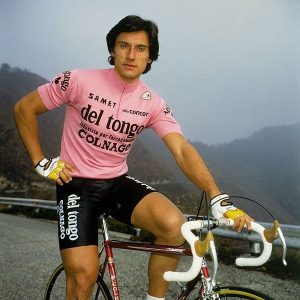Few riders have encapsulated the heart and soul of Italian cycling like Giuseppe Saronni. Sleek, stylish, and ruthlessly fast, Saronni wasn’t just a champion—he was a symbol of a new era. Racing through the 1980s with a magnetic combination of sprinting brilliance and tactical sharpness, he captured not only pink jerseys and stage wins, but the imagination of a nation divided between tradition and transformation.
From his explosive arrival on the professional scene to his iconic rivalry with Francesco Moser, Saronni’s story is one of daring attacks, media frenzy, and victories that redefined what it meant to be a Giro d’Italia winner.
The early years: from Novara to national promise
Born in Novara in 1957 and raised in nearby Parabiago, Giuseppe Saronni burst into the spotlight as a precociously talented junior. His rapid rise was unmistakable. By the time he turned professional in 1977, it was clear that Saronni wasn’t just another fast-finishing sprinter—he was a generational talent.
His early results included stage wins and strong showings in the Giro, setting the stage for what would become a career intertwined with the race’s most dramatic moments.
Saronni vs. Moser
Italian cycling fans of the 1980s often found themselves in one of two camps: Team Saronni or Team Moser.
Where Moser was seen as the rugged, stoic northerner with diesel-like consistency, Saronni was the flashy southerner, all elegance and emotion. Their rivalry was the defining narrative of Italian cycling for nearly a decade.
They clashed in the Giro, the World Championships, and even in their personalities. The media fueled the rivalry, but what made it unforgettable was the way each pushed the other to new heights. When Saronni attacked, Moser answered. When Moser won, Saronni came back stronger.
Giro d’Italia 1983
 If 1979 had been the triumph of youthful energy, Saronni’s 1983 Giro win was all about maturity and control. This time, there were no surprises. Saronni entered the race as a favorite, took the maglia rosa after Stage 5, and never gave it up.
If 1979 had been the triumph of youthful energy, Saronni’s 1983 Giro win was all about maturity and control. This time, there were no surprises. Saronni entered the race as a favorite, took the maglia rosa after Stage 5, and never gave it up.
He showcased not only tactical brilliance but also endurance and consistency, winning five stages and dominating the competition in the final time trial. It was a commanding performance that proved his earlier success was no fluke.
His second Giro win cemented Saronni’s status as one of the most complete Italian riders of the modern era.
Beyond the Giro
Saronni’s talent wasn’t confined to Italy. In 1982, he delivered one of the most iconic victories in modern cycling by winning the World Championship Road Race in Goodwood, England. His final sprint—launched with chilling precision from over 300 meters—became known as the “fucilata di Goodwood” (the rifle shot).
The image of Saronni crossing the line, arms raised in rainbow colors, is one of the most enduring snapshots of 1980s cycling. It was the kind of win that made people believe in magic.